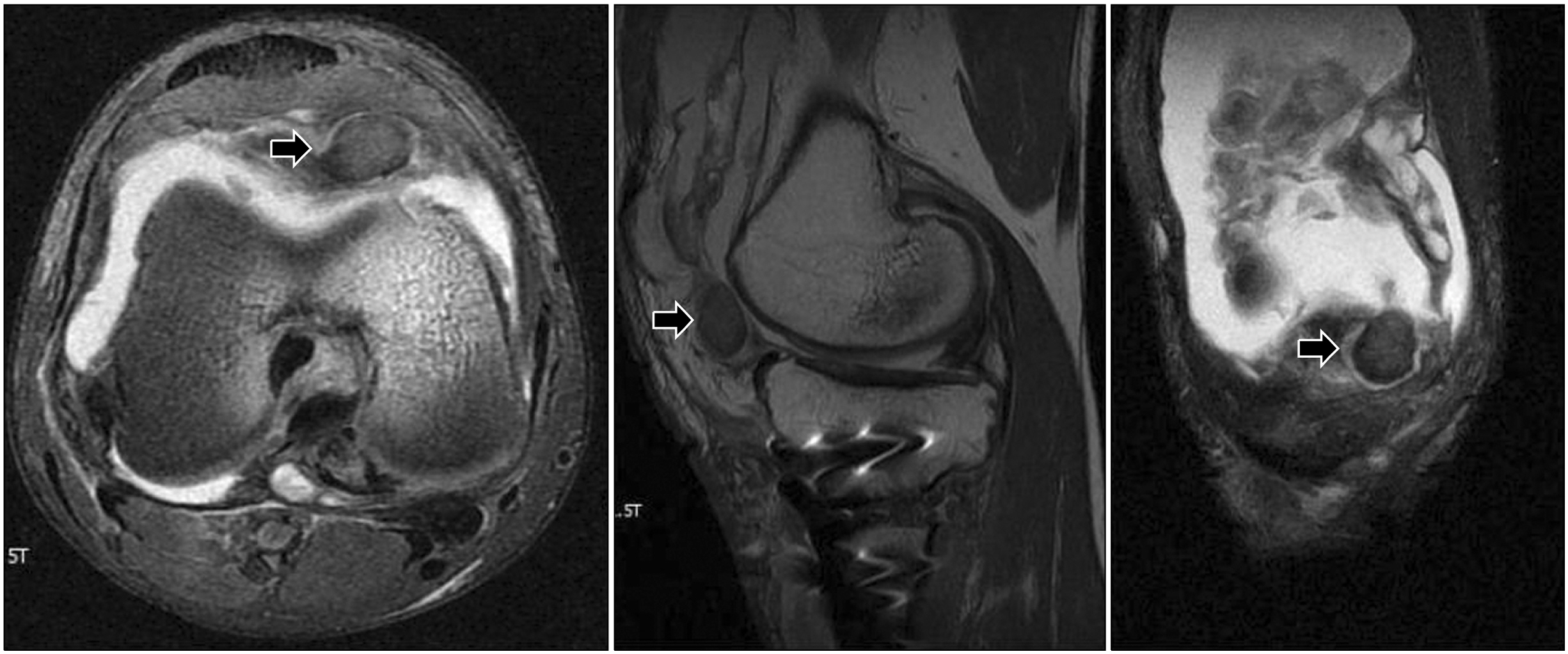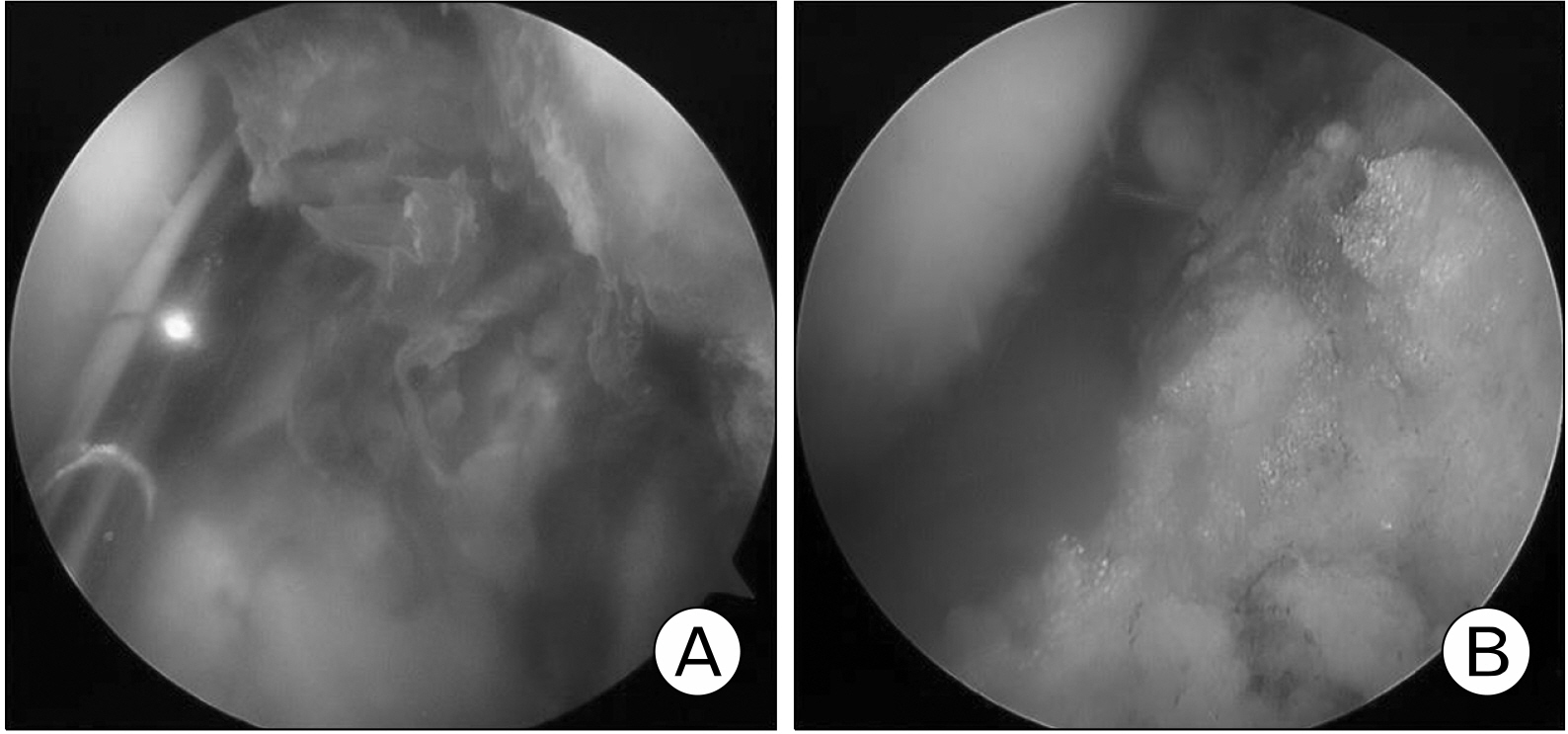Korean J Sports Med.
2023 Mar;41(1):50-53. 10.5763/kjsm.2023.41.1.50.
Arthroscopic Electrocautery Treatment for Pseudoaneurysm of Inferomedial Genicular Artery after Arthroscopic Anterior Cruciate Ligament Reconstruction and High Tibial Osteotomy
- Affiliations
-
- 1Department of Orthopedic Surgery, Yes Hospital Guro, Seoul, Korea
- KMID: 2539690
- DOI: http://doi.org/10.5763/kjsm.2023.41.1.50
Abstract
- Knee arthroscopy is a widely performed procedure with few complications and low risk. Vascular complications are also very rare, and pseudoaneurysm is one of the few serious vascular complications. It occurs frequently in the popliteal artery but rarely occurs in the genicular artery. Pseudoaneurysms are caused by damage to the blood vessel wall due to various causes such as trauma and local extravasation. Depending on the size or location, surgical treatments such as intervention embolization or ligation are performed. In this study, after arthroscopic anterior cruciate ligament reconstruction, a pseudoaneurysm of the medial inferior branch of genicular artery occurred near the arthroscopic medial portal site and the lesion was treated successfully with arthroscopic electrocautery.
Keyword
Figure
Reference
-
1. Audenaert E, Vuylsteke M, Lissens P, Verhelst M, Verdonk R. 2003; Pseudoaneurysm complicating knee arthroscopy: a case report. Acta Orthop Belg. 69:382–4.2. Carey LC, Stremple JF. 1967; An aneurysm of the anterior tibial artery: a case report. Angiology. 18:117–21. DOI: 10.1177/000331976701800206. PMID: 6018540.3. van Hensbroek PB, Ponsen KJ, Reekers JA, Goslings JC. 2007; Endovascular treatment of anterior tibial artery pseudoaneurysm following locking compression plating of the tibia. J Orthop Trauma. 21:279–82. DOI: 10.1097/BOT.0b013e3180500371. PMID: 17414557.4. Sarrosa EA, Ogilvie-Harris DJ. 1997; Pseudoaneurysm as a complication of knee arthroscopy. Arthroscopy. 13:644–5. DOI: 10.1016/S0749-8063(97)90195-X. PMID: 9343657.5. Sayit E, Bagir M, Tanrivermis Sayit A. 2017; Pseudoaneurysm of the common digital artery with magnetic resonance imaging and surgical findings. Ann Vasc Surg. 42:304.e7–10. DOI: 10.1016/j.avsg.2017.03.165. PMID: 28385502.6. Hilborn M, Munk PL, Miniaci A, MacDonald SJ, Rankin RN, Fowler PJ. 1994; Pseudoaneurysm after therapeutic knee arthroscopy: imaging findings. AJR Am J Roentgenol. 163:637–9. DOI: 10.2214/ajr.163.3.8079859. PMID: 8079859.
- Full Text Links
- Actions
-
Cited
- CITED
-
- Close
- Share
- Similar articles
-
- Popliteal Artery Pseudoaneurysm after Arthroscopic Posterior Cruciate Ligament Reconstruction: A Case Report
- Popliteal Pseudoaneurysm after Arthroscopic Posterior Cruciate Ligament Reconstruction
- Bilateral Medial Tibial Plateau Fracture after Arthroscopic Anterior Cruciate Ligament Reconstruction
- Pseudoaneurysm of the Medial Superior Genicular Artery after Arthroscopic Partial Meniscectomy
- Arthroscopic Revision Anterior Cruciate Ligament Reconstruction: Report of 5 Cases





